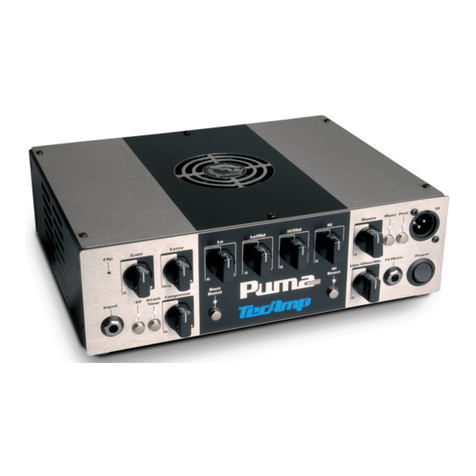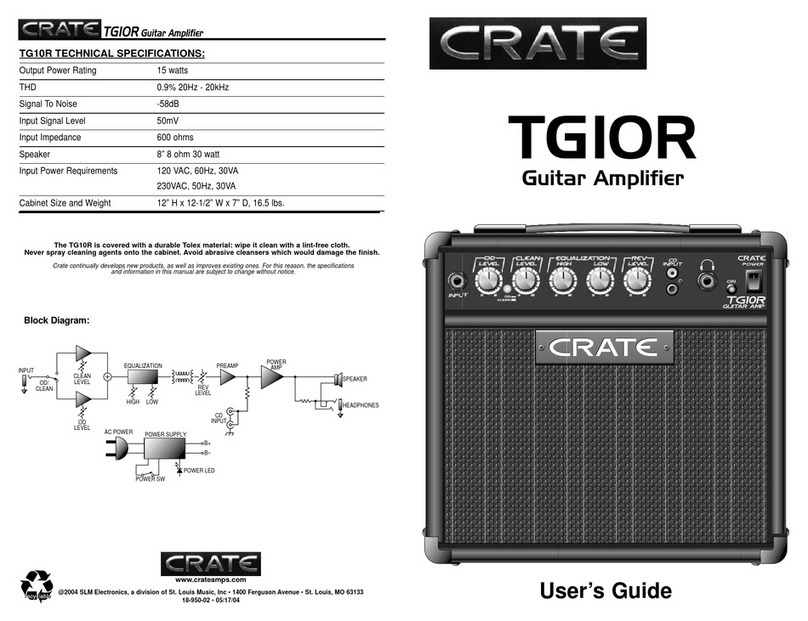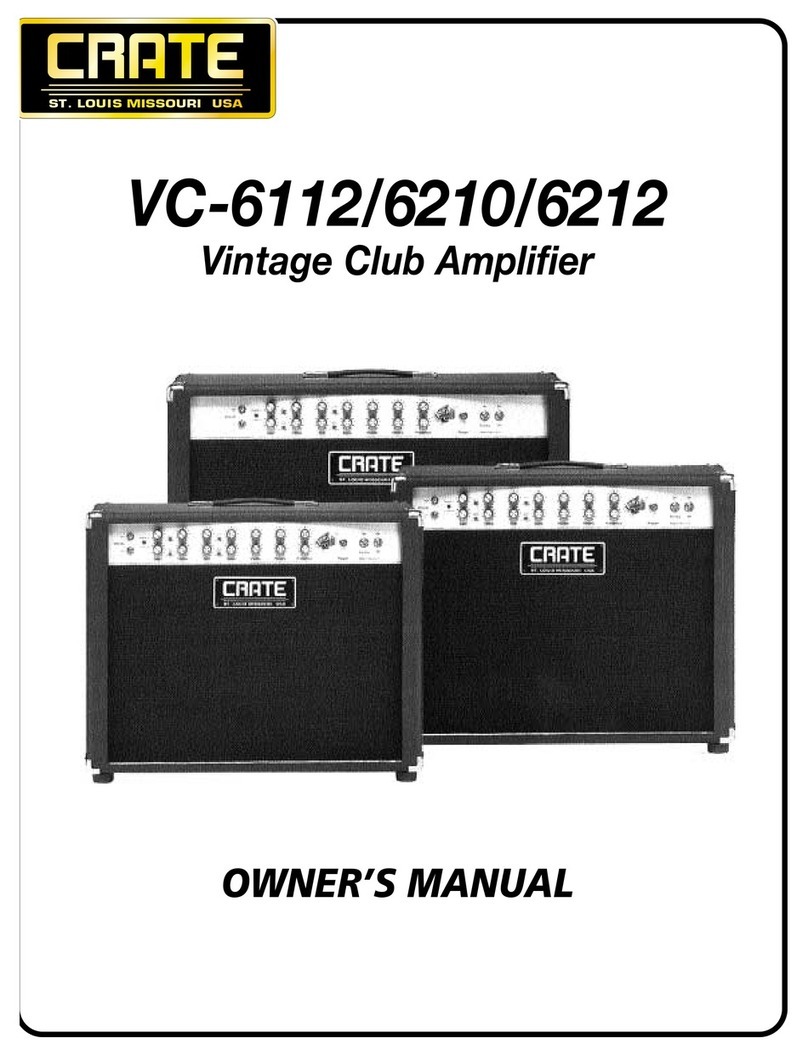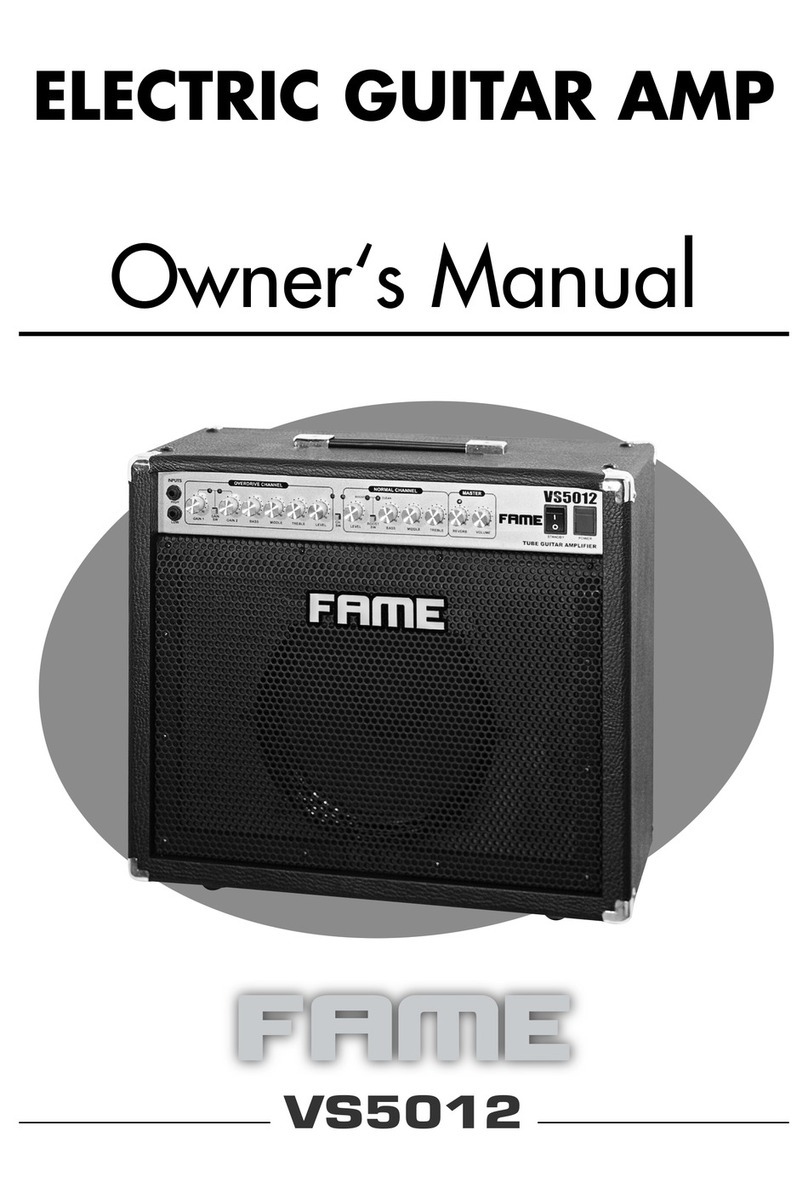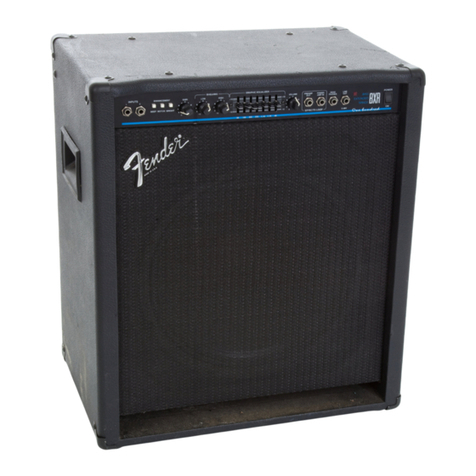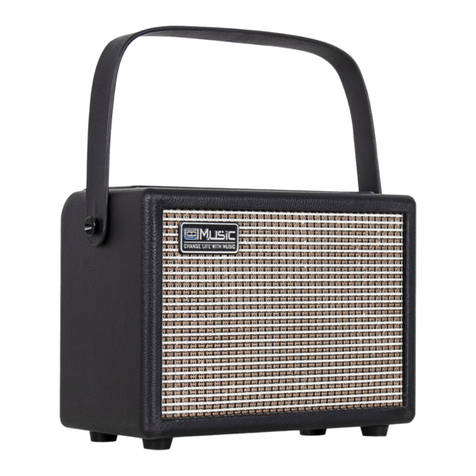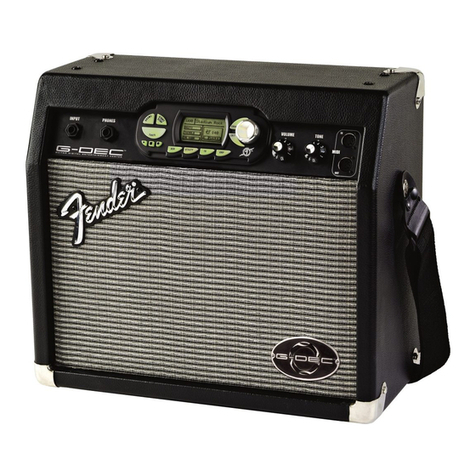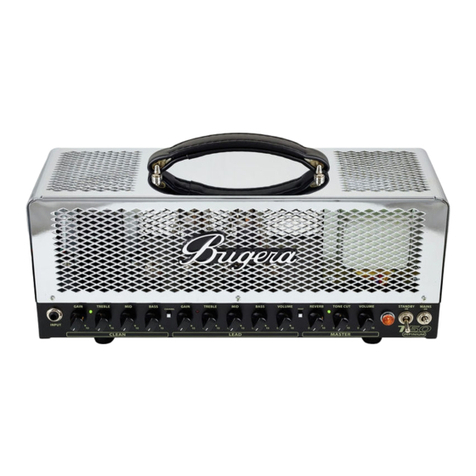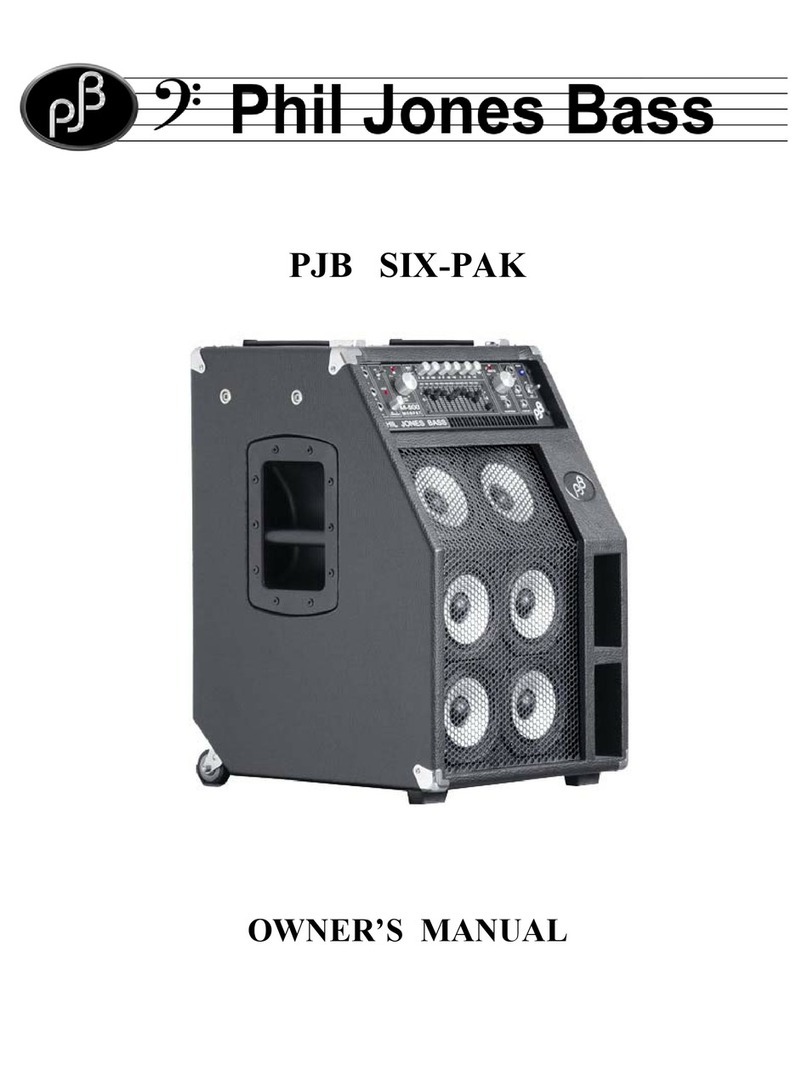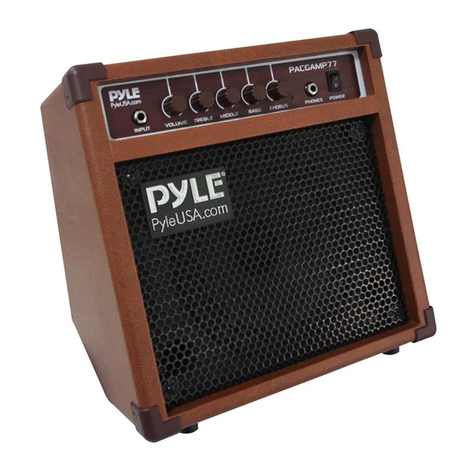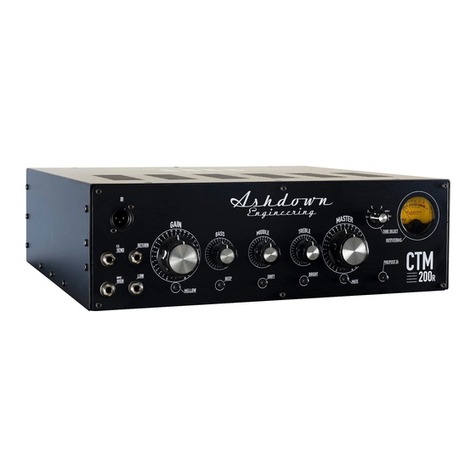Blumentritt Amplification Texas Tone Ranger User manual

Blumentritt Amplification Texas Tone Ranger Owner's Manual 1
Texas Tone Ranger Owner’s Manual
Congratulations!
You are now the proud owner of the Texas Tone™ Ranger tube guitar amplifier. This amp packs a
dynamic vintage tube sound with two channels into a single combo cabinet –giving you an amp that’s
easy to operate, easy to transport, and produces those sweet tube amp sounds that we all crave!
Like all Blumentritt Amplification Texas Tone™ products, your Texas Tone Ranger amplifier is designed
by musicians and built using the finest components available. Extensive testing confirms that this
amplifier is the absolute best it can be. In order to get the most out of your new amplifier, we strongly
urge you to read the information contained in this manual before you begin playing.
Thank you for choosing Texas Tone™!

Blumentritt Amplification Texas Tone Ranger Owner's Manual 2
READ, FOLLOW, HEED, AND KEEP ALL INSTRUCTIONS AND WARNINGS.
CAUTION: RISK OF ELECTRIC SHOCK, DO NOT OPEN OR REMOVE CHASSIS!
WARNING: TO REDUCE THE RISK OF FIRE OR ELECTRIC SHOCK, DO NOT EXPOSE THIS APPARATUS TO RAIN OR
MOISTURE. DO NOT REMOVE REAR COVER. NO USER-SERVICEABLE PARTS INSIDE.
•WARNING: THIS UNIT REQUIRES A SAFETY GROUNDED 120VAC 60Hz OUTLET WIRED TO CURRENT
ELECTRIC CODES. ONLY CONNECT POWER CORD TO A POLARIZED, SAFETY GROUNDED OUTLET WIRED TO
CURRENT ELECTRICAL CODES AND COMPATIBLE WITH VOLTAGE, POWER, AND FREQUENCY
REQUIREMENTS STATED ON THE REAR PANEL OF THE AMPLIFIER.
•WARNING: THIS AMPLIFIER PRODUCES HIGH DC VOLTAGE (~400+ VDC). DO NOT REMOVE THE CHASSIS
OR OPERATE WITH THE CHASSIS REMOVED.
•SERVICE TO BE PERFORMED BY QUALIFED PERSONNEL ONLY.
•DO NOT OPERATE NEAR ANY HEAT SOURCE AND DO NOT BLOCK ANY VENTILATION OPENINGS ON THIS
AMPLIFIER. FOR PROPER OPERATION, THIS UNIT REQUIRES 3” (75mm) OF WELL-VENTILATED SPACE
AROUND HEATSINKS AND OTHER AIR FLOW PROVISIONS IN THE CABINET.
•WARNING: TO REDUCE THE RISK OF ELECTRIC SHOCK OR FIRE, DO NOT EXPOSE THIS UNIT TO RAIN OR
MOISTURE. DO NOT USE THIS AMPLIFIER NEAR SPLASHING, FALLING, SPRAYING, OR STANDING LIQUIDS.
•CLEAN ONLY WITH LINT-FREE DAMP CLOTH AND DO NOT USE CLEANING AGENTS.
•PROTECT THE POWER CORD FROM DAMAGE DUE TO BEING WALKED ON, PINCHED, OR STRAINED.
•UNPLUG THE AMPLIFIER DURING LIGHTNING STORMS OR WHEN UNUSED FOR LONG PERIODS OF TIME.
•ONLY USE ATTACHMENTS, ACCESSORIES, STANDS, OR BRACKETS SPECIFIED BY THE MANUFACTURER FOR
SAFE OPERATION AND TO AVOID INJURY.
•OUR AMPLIFIERS ARE CAPABLE OF PRODUCING HIGH SOUND PRESSURE LEVELS. CONTINUED EXPOSURE
TO HIGH SOUND PRESSURE LEVELS CAN CAUSE PERMANENT HEARING IMPAIRMENT OR LOSS. USER
CAUTION IS ADVISED, AND EAR PROTECTION IS RECOMMENDED IF UNIT IS OPERATED AT HIGH VOLUME.
Contents
Congratulations! ...........................................................................................................................................1
READ, FOLLOW, HEED, AND KEEP ALL INSTRUCTIONS AND WARNINGS......................................................2
The Texas Tone Ranger.................................................................................................................................3
Specific Features of the Texas Tone Ranger: ............................................................................................4
Block Diagram ...........................................................................................................................................4
The Front Panel:............................................................................................................................................5
The Rear Panel (not shown):......................................................................................................................... 7
Important Information about Guitar Amp Vacuum Tubes (Valves): ............................................................ 8
Tube Types and Usage: ............................................................................................................................. 8
Tubes: Why (And When) To Replace Them: ............................................................................................. 9
Whenever you replace the power tubes: .............................................................................................9
Survival Tips for Tube Amplifiers: ...........................................................................................................10

Blumentritt Amplification Texas Tone Ranger Owner's Manual 3
The Texas Tone Ranger
While the Texas Tone Ranger is inspired by the dynamic performance of the Marshall 18 Watt, the
Ranger has actually very little in common with that great amp besides the chassis and cabinet. We have
added some unique touches and modern safety and construction methods.
Vintage tube guitar amplifiers suffer from outdated electrical grounding methods. Texas Tone™guitar
amps feature modern grounding techniques and three-prong electrical plugs for safe, low-noise
operation. Many amps from the 1950s also have very little clean headroom. Special features allow the
Texas Tone Ranger extra headroom when needed, or total tube amp distortion. This allows the guitarist
to get that sweet and creamy tube crunch, or to tame those vintage sounds, depending upon the control
panel settings.
The Texas Tone Ranger features two independent channels and controls. Both channels are augmented
by shielded inputs and a shock-mounted first-stage preamp tube. The left-side vintage channel features
the unique Texas Tone™Hi-pass/Low-pass Tone control that provides tone enhancements without
affecting the volume control. This channel provides a single gain stage with a traditional mid 1960’s
tube amp “clean”sound that can be cranked for tube amp crunch without being too loud for smaller
venues, studio use, or practicing at home, and is very pedal friendly.
This right-side channel’s gain stage is followed by a Gain control for the unique tone stack that is
responsive and low loss, with Treble and Bass controls, with by a Volume control before the phase
splitter. By adjusting the Gain and Volume controls, the guitarist can get anything from clean and loud
to smooth overdrive.
From clean to dirty, this amp allows you to remain in control of your sound; you will be surprised at the
variety of tones you can achieve with this amp.

Blumentritt Amplification Texas Tone Ranger Owner's Manual 4
Specific Features of the Texas Tone Ranger:
•Shock-mounted first stage preamp tube.
•American made transformers
•Isolated Standby switch
•MIL-Spec wire
•Low-noise resistors
•Shielded signal cables
•High quality F&T, JJ, Mallory and Sprague Capacitors
•Hand-wired turret board
•Rugged aluminum chassis.
•Two independent, differently voiced channels
•Texas Tone™unique Tone control and Tone Stack
•Eminence® Screamin Eagle 12” speaker –Bright and articulate tone with screamin top end and
tight bass.
Block Diagram

Blumentritt Amplification Texas Tone Ranger Owner's Manual 5
The Front Panel:
1. INPUTS: Texas Tone Ranger has two independent channels, each with High and Low input jacks.
a. HIGH Input: This is the normal, high gain, high impedance (1MegΩ) input. Connect your
guitar here by means of a shielded signal cable.
b. LOW Input: The “Low” input features a -6dB attenuation compared to the “High” Input. Use
the low input for lower gain and quieter performance, or when using very high-gain pickups
to gain more headroom before the onset of distortion. When both inputs are used at the
same time, they offer the same gain characteristics.
2. LEFT CHANNEL
a. VOLUME: Use this control to adjust the input gain and overall volume level. With the
control towards the counter-clockwise position, the gain is low and very little distortion is
produced. As you rotate the control clockwise the gain increases, producing more
overdrive distortion and a higher output volume level.
b. TONE: The unique Tone control on the Texas Tone Ranger offers less interaction with the
volume control than a typical vintage amplifier tone control circuit. It’s subtle, and yet
offers a wide range of tone control. If you’re used to vintage-type tone control circuits that
interact with the volume control, you may be surprised and pleased that this tone control
circuit doesn’t raise or lower the volume as you rotate the tone control. As the control knob
is rotated clockwise, more treble frequencies are emphasized.
3. RIGHT CHANNEL
a. GAIN: Use this control to adjust the input gain driving the tone stack. For the cleanest tone,
set the Volume on maximum and run the Gain control at a lower setting.
NOTE: Due to the high gain/low loss structure of the Texas Tone Ranger, we do not
recommend running the gain at the maximum setting, above the 3 O’Clock position.
b. TREBLE: Turning the Treble control clockwise from the mid-point (straight up) produces a
brighter tone. Counter-clockwise reduces the high frequency response.
c. BASS: The Bass knob controls the response of the lower frequencies. Clockwise for more
bass, counter-clockwise for less.
d. VOLUME:Use this control to set the overall volume driving the output section of the Texas
Tone Ranger. For cleanest tone, run this control at maximum. Most guitarists seem to like a
mix of Gain and Volume to get a pleasant tube breakup.
4. Standby switch: The isolated Standby switch controls the high voltage to the tubes of the Texas
Tone Ranger. The Standby switch may also be used to quiet the amplifier for short periods.
5. Power switch: To turn on the amplifier, make sure that the Standby switch is in the “STANDBY”
position, and then turn on the power switch. After sufficient time for the tubes to warm up, about

Blumentritt Amplification Texas Tone Ranger Owner's Manual 6
15 seconds, turn on the Standby switch. To turn off the amplifier, place the Standby switch back to
the STANDBY position, and switch off the Power switch.
6. Indicator lamp: The lamp will illuminate whenever the amplifier is plugged in to a 120V power
source and the Power switch is turned on.

Blumentritt Amplification Texas Tone Ranger Owner's Manual 7
The Rear Panel (not shown):
1. 120 VAC Fuse Holder: Use only a 3AG type Slow Blow 2 Amp rated fuse. In the event that the fuse
blows or the amplifier will not power on, consult a qualified tube amp technician.
2. Line Cord: The grounded power cord should only be plugged into a grounded power outlet that
meets all applicable electrical codes and is compatible with 120 Volts AC, 60 Hz power. Do not
attempt to defeat the safety ground connection.
3. High Voltage Fuse Holder: Use only a 3AG type Slow Blow 500mA (1/2 Amp) rated fuse for the high
voltage (~400V DC). In the event that the fuse blows or the amplifier will not power on, consult a
qualified tube amp technician.
4. Tube sockets (from left to right –not shown):
a. V6: Rectifier. Solid State 8-pin 1N5408 diode rectification is standard, to provide snappy
response and a tight feel. For a slightly looser feel, a high quality GZ34/5AR4 type rectifier
tube may be used. A 5U4 type will provide a great deal of “sag”.
b. V4 & V5: Power output tubes. Use only a matched pair of high quality 5881 tubes. A
Premium Matched pair of Tung-Sole 5881 (Short Bottle) new production tubes is standard.
The power tubes utilize self-biasing Cathode bias, set at around 92% maximum dissipation,
designed specifically for the Tung-Sol 5881 tubes. Any substitution will alter the bias. While
it is possible to substitute 6L6 or oven 6V6 power tube matched pairs, bear in mind at 6L6’s
will be biased cool, and 6V6’s may be over-biased.
c. V3: Phase splitter. The phase splitter circuit in the Texas Tone Ranger is specially designed
to use a 12AX7 type tube for maximum bandwidth and drive. Use only a high quality
12AX7/ECC83/7025 type vacuum tube. A JJ Electronics ECC83S (12AX7) tube is standard. A
12AY7 tube may be used, resulting in less drive to the power tubes.
d. V2: Preamplifier and tone stack driver. Use only a high quality 12AX7/ECC83/7025 type
vacuum tube. JJ Electronics ECC83S (12AX7) is standard for its outstanding low noise
characteristics.
e. V1: First stage preamplifier tube. Use only a high quality 12AX7/ECC83/7025 type vacuum
tube. A JJ Electronics ECC83S (12AX7) is standard. The V1 tube socket is shock-mounted to
aid in reducing noise.
5. Speake Impedance Selector: The Classic Tone™output transformer of the Texas Tone Ranger can
drive speakers rated at 4Ω, 8Ω, or 16Ω. The Eminence® Screamin Eagle standard speaker is rated at
8 Ohms. This speaker is chosen for its soarin’ solos and tight rhythm capabilities. Bright and
articulate tone with screamin top end and tight bass. A good club speaker for American Blues and
Rock. Use of a different speaker or an external speaker requires setting the Impedance Selector
switch at the proper setting for the speaker(s) being driven. Always have the amp powered down
before changing speaker connections.
6. Speaker connector: The Texas Tone Ranger ships with a 1/4” cable connected from the 8Ω chassis
speaker jack to the internal Eminence® 8Ω speaker.There is an additional speaker output for an
extension cabinet.
NOTE: Do not power on or operate the amplifier without a speaker plugged in! Damage will
result.

Blumentritt Amplification Texas Tone Ranger Owner's Manual 8
Important Information about Guitar Amp Vacuum Tubes (Valves):
The sound produced by a tube-powered amplifier is significantly different from that produced by a solid-
state amplifier with similar design specifications. When pushed past their limits, solid-state devices tend
to go immediately into distortion.
Tubes, on the other hand, are non-linear devices that transition more smoothly into distortion, and
produce a more musical set of harmonics, the intensity of which can be controlled by the player. This
characteristic adds warmth and definition to the sound, which has become the hallmark of tube
amplifiers. When tubes are driven into clipping, the harmonic overtones can be both sweet and
pleasing, or intense and penetrating, depending on the musician’s musical taste and playing technique.
Modern application engineers have designed a number of outstanding solid-state amplifiers that sound
quite good. Some use modeling circuitry that enables them to simulate the distortion characteristics of
a tube amplifier. Since the response of tubes is both dynamic and non-linear, the true range of
characteristics of tube amplifiers can only be approximated. Modern tube amplifiers such as Texas
Tone™ amps, offer that classic, dynamic vintage sound in today’s contemporary market.
Tube Types and Usage:
Preamp tube circuits amplify the signal from your instrument and shape the sound, and they can
sometimes become microphonic (mechanically pick up and transmit external noises). Since these tubes
are used in the critical first stages of a tube amplifier's circuitry, it is very important to use high quality,
low noise/low microphonic tubes for this application. Although tubes of this quality may typically cost
more than standard tubes, the improvement in performance is worth the investment, and in some
cases, critical. Blumentritt Amplification performs extensive testing and works with tube suppliers to
determine the best tube for each position in the amplifier.
Preamplifier tubes are also used to drive the power tubes. The power tubes convert the low-level,
conditioned signal from the preamplifier into a level that is sufficient to drive the speakers. There are
several types of power tubes available, each of which offers a different performance/sound
characteristic. The 5881 tubes used in the Texas Tone Ranger produce a full range, rich and creamy
sound with nice distortion. Some tubes are available in matched sets. These tubes are extensively
tested for optimum performance and longevity. Matched sets of power tubes are highly recommended.
A Premium Matched pair of new production Tung-Sol 5881 tubes is standard on the Texas Tone Ranger.

Blumentritt Amplification Texas Tone Ranger Owner's Manual 9
Tubes: Why (And When) To Replace Them:
Tubes are made of a number of fragile mechanical components that are vacuum-sealed in a glass
envelope. The longevity of a tube depends upon a number of factors, including how hard and often the
amplifier is played, vibration from the speakers, road travel, repeated set up and tear down, etc. Any
time you notice a change in your amplifier's performance, check the tubes first.
If it has been a while since the tubes were replaced and the sound from your amplifier lacks punch,
fades in and out, loses highs or lows or produces unusual sounds, the power tubes may need replacing.
If your amplifier squeals, makes noise, loses gain, starts to hum, lacks dynamic sensitivity, or feels as if it
is working against you, the preamplifier tubes may need replacing.
The power tubes are subjected to considerably more stress than the preamplifier tubes. Consequently,
they usually fail/degrade first. If deteriorating power tubes are not replaced, they will ultimately fail.
Depending on the failure mode, they may even cause severe damage to the audio output transformer
and/or other components in the amplifier. Replacing the tubes before they fail completely has the
potential to save you time, money and unwanted trouble. Since power tubes work together in an
amplifier, it is crucial that they are replaced by a matched set. If you are on the road a lot, we
recommend that you carry a spare matched set of replacement power tubes and their associated driver
tubes.
After turning off the power and disconnecting the amplifier from the power source, carefully check the
tubes (in bright light) for cracks or white spots inside the glass or any other apparent damage. Then,
with the power on, view the tubes in a dark room. Look for preamplifier tubes that do not glow at all or
power tubes that glow excessively red.
Whenever you replace the power tubes:
The output tubes of the Texas Tone Ranger are biased with an adjustable fixed bias. When changing the
output tubes, it is important to validate and possibly adjust the negative bias voltage. The output
section of the Texas Tone Ranger is designed for long tube life. When the output tubes are replace, we
recommend that you replace the phase inverter tube as well. The phase inverter tube determines the
shape and amplitude of the signal applied to the power tubes and has to work almost as hard as the
power tubes. The phase inverter on the Texas Tone Ranger is a special design that yields wide
bandwidth and gain characteristics when used with a 12AX7 tube.
You can check your preamplifier tubes for microphonics by turning the amplifier on, turning up the gain
and tapping lightly on each tube with a chopstick or other light wooden dowel. You will be able to hear
the tapping through your speakers, which is normal. It is not normal for a tube to ring like a bell after it
is tapped. If it does ring then it is microphonic and should be replaced. The first stage preamp tube in
shock-mounted to reduce noise and microphonics. Remember to use only high quality, low microphonic
tubes in the preamplifier section. Even though power tubes are rarely microphonic, you should check
them anyway. The power tubes can be checked for microphonics just like pre-amp tubes.

Blumentritt Amplification Texas Tone Ranger Owner's Manual 10
Survival Tips for Tube Amplifiers:
To prolong tube life, observe these tips and recommendations:
•Make sure the speaker(s) are properly connected prior to turning on the amplifier. DO NOT
OPERATE THE AMPLIFIER WITHOUT A SPEAKER OR PROPER DUMMY LOAD ATTACHED. TO DO
SO WILL DAMAGE THE AMPLIFIER.
•Allow the amplifier to warm up to room temperature before turning it on. The heat generated
by the tube elements can crack the cold glass housing.
•After playing the amplifier, allow sufficient time for it to properly cool down prior to moving it.
A properly cooled amplifier prolongs tube life due to the internal components being less
susceptible to the damage caused by vibration.
•Match the impedance of your speaker cabinet(s) to your amplifier. Improper impedance
matching will contribute to early tube degradation and may cause premature tube failure.
•Replace the output tube(s) before the performance degrades or the tubes fail completely.
Check the tube(s) when you notice degraded performance.
•If the locating notch on the base of a power tube breaks off, replace the tube. This significantly
reduces the risk of damaging your amplifier by incorrectly inserting the tube.
•Protect the amplifier from dust and moisture. If liquid gets into the amplifier proper, or if the
amplifier is dropped or otherwise mechanically abused, have it checked out at an authorized
service technician before using it.
•Proper maintenance and cleaning in combination with routine checkups by an authorized
technician will insure the best performance and longest life from your amplifier.
CAUTION: Tube replacement should be performed only by qualified service personnel who are familiar
with the dangers of hazardous voltages that are typically present in tube circuitry.
Texas Tone Ranger TECHNICAL SPECIFICATIONS:
Output Power Rating
22W RMS into an 8 Ohm load
Gain:
65Db Typical
Tone Controls
Treble+/- 12 dB @ 10k Hz
Middle+/- 20 dB @ 500 Hz
Internal Speaker
12”, 50W Eminence®, 8Ω, 1.75” copper
voice coil, 38 oz. ferrite magnet, 100.8dB
sensitivity, 79 Hz resonant freq.
Preamp Tubes
3 x ECC83s JJ
Power Tubes
2 x 5881 Tung-Sol Matched Pair
Rectifier Tube
1N5408 Diodes in an 8-pin package
Power Requirements
120VAC, 60Hz
Size and Weight
(H) 21" x (W) 24" x (D) 9.5", 40 lbs.
The Texas Tone Ranger is covered with a durable Tolex material: wipe it clean with a lint-free cloth.
Never spray cleaning agents onto the cabinet. Avoid abrasive cleansers, which would damage the finish.
Specifications and information in this manual are subject to change without notice.
Table of contents

